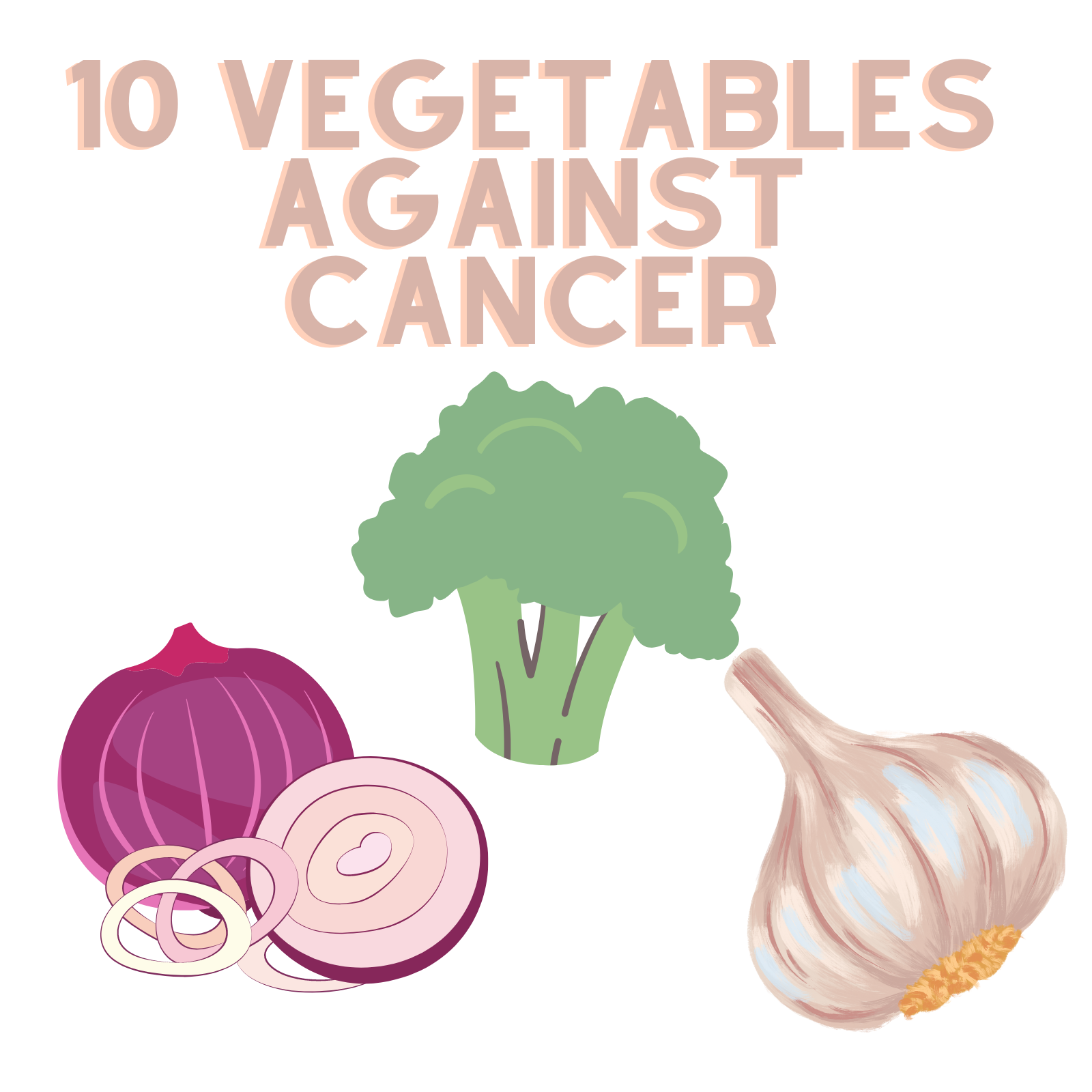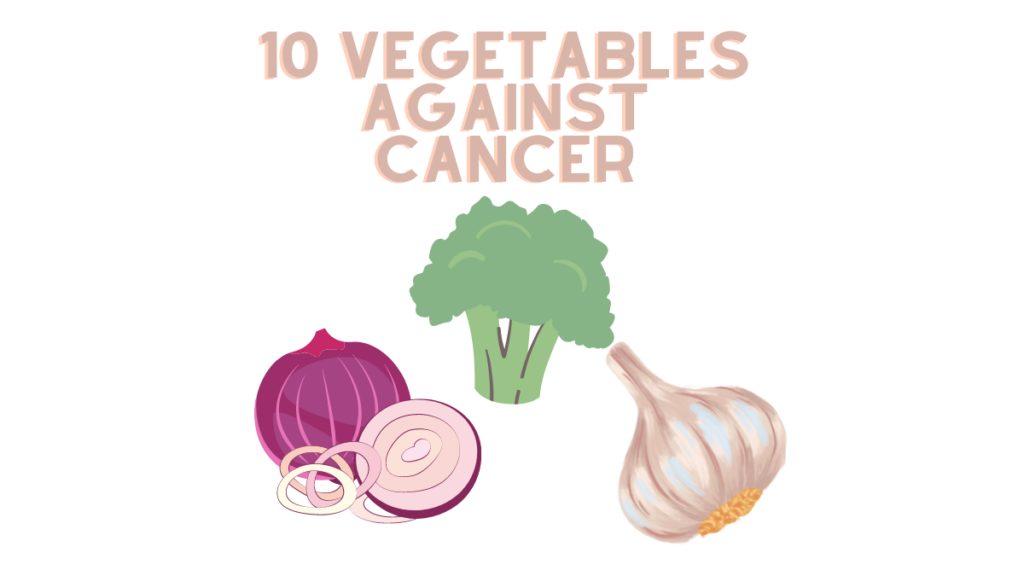
10 Vegetables Against Cancer
Introduction

10 Vegetables Against Cancer
In this article we will go over 10 Vegetables Against Cancer. I will try to outline and cite as much research data possible in order to give you perspective on why specific vegetables combat cancer from a scientific point of view based on the data.
Keep in mind that I’m not a health professional nor do I condone the use of vegetables alone to combat cancer. This is mainly to prevent and reduce your risk from cancer but there’s a lot of other factors that come into play including heredatery. Always consult your primary physician before reaching into any conclusions, this article is just here to give you my perspective.
Broccoli
Broccoli is a vegetable that is part of the cabbage family. It is green and has a tree-like appearance. Broccoli is a good source of fiber, vitamins C, K, and A. It also contains potassium and magnesium. Broccoli can be eaten raw, steamed, boiled, or roasted.
Broccoli is a healthy vegetable that has many nutrients that are beneficial to the body. Fiber helps with digestion, vitamins C and A are antioxidants, and vitamin K helps with blood clotting. Potassium and magnesium are minerals that are important for heart health and bone health. Broccoli can be eaten raw, steamed, boiled, or roasted. Raw broccoli has the most nutrients, but some people prefer it cooked. Steaming broccoli preserves the most nutrients. Boiling broccoli causes it to lose some of its nutrients, but it is still a healthy vegetable. Roasting broccoli gives it a different flavor and texture.
Eating broccoli is a great way to get important nutrients into your diet. It is a versatile vegetable that can be eaten raw or cooked in many different ways. Broccoli is a healthy choice for a snack or a side dish.
Cauliflower
Cauliflower is a cruciferous vegetable that is often white or off-white in color. It is composed of a head of tightly packed florets that are surrounded by leaves. Cauliflower is a cool weather crop that is typically grown in the spring or fall. It is a good source of vitamins C and K, as well as fiber. Cauliflower can be eaten raw, cooked, or pickled. It is often used as a low-carb substitute for rice or potatoes.
Brussels Sprouts
Brussels sprouts are a type of cabbage that is grown in the Brussels region of Belgium. The sprouts are small, green, and have a slightly bitter taste. They are often served boiled or steamed as a side dish.
Brussels sprouts were first cultivated in the 16th century in Brussels, Belgium. They were originally grown for their leaves, which were used as a type of cabbage. The sprouts were not eaten until the 19th century, when they became a popular side dish.
Today, Brussels sprouts are grown in many parts of the world, including the United States, Canada, and Europe. They are available year-round, but are most commonly eaten in the fall and winter.
When choosing Brussels sprouts, look for ones that are small and firm. Avoid those that are yellow or have brown spots. Store them in the refrigerator in a plastic bag.
To prepare Brussels sprouts, wash them thoroughly and remove any yellow or brown leaves. Cut them in half and boil or steam for 3-5 minutes. Serve with butter or lemon juice.
Kale
idoscope
A kaleidoscope is a tube of mirrors containing loose, brightly colored objects. As you look into one end of the kaleidoscope, the light reflects off the mirrors and creates a beautiful, ever-changing pattern of colors and shapes.
Kaleidoscopes were first invented in the early 1800s, and they quickly became popular toys. Today, kaleidoscopes are still enjoyed by people of all ages. They are often used as decoration, and many people collect them.
Kaleidoscopes are fascinating to look at because they produce such intricate and beautiful patterns. The patterns are always changing, so there is always something new to see. Each time you look into a kaleidoscope, you are sure to have a unique experience.
Garlic
Garlic is a plant in the Allium (onion) family. It is native to Central Asia and northeastern Iran, and has long been a common seasoning worldwide, with a history of several thousand years of human consumption and use. It was known to the ancient Egyptians, and has been used both as a food flavoring and as a traditional medicine.
The garlic plant’s bulb is the most commonly used part of the plant. The bulb is divided into numerous fleshy sections called cloves. The cloves are used for consumption (raw or cooked) or for medicinal purposes.
Garlic is low in calories and contains no cholesterol. It is a good source of vitamins B6 and C, and minerals such as manganese and selenium. Garlic also contains trace amounts of other minerals including calcium, copper, iron, magnesium, phosphorus, potassium, and zinc.
Garlic has a long history of use as a medicinal herb. It is said to have many health benefits, including the ability to boost the immune system, fight off infections, and reduce inflammation. Some people also believe that garlic can help to lower blood pressure and cholesterol levels.
Onion
Onions are a staple in many kitchens around the world. They add flavor and depth to dishes, and can be used in both sweet and savory recipes. While onions may not be the most glamorous of ingredients, they are certainly one of the most versatile.
Onions are a member of the Allium family, which also includes garlic, leeks, and shallots. They are thought to have originated in central Asia, and have been cultivated for thousands of years. Today, onions are grown in many different parts of the world.
There are many different types of onions, including red, white, and yellow varieties. The most common type of onion in the United States is the yellow onion.
Onions can be eaten raw, cooked, or pickled. They are often used as a base ingredient in soups, stews, and sauces. Onions can also be grilled, roasted, or sautéed.
When cutting an onion, it is important to use a sharp knife. This will help to prevent the onion from bruising. To avoid tears, you can cut the onion under running water.
If you are looking for a way to add more flavor to your dishes, consider using onions. They are a versatile ingredient that can be used in many different ways. So don’t be afraid to experiment with them in your cooking!
Shallot
A shallot is a small, edible onion-like bulb. The word “shallot” can also refer to the plant that produces this bulb. Shallots are a member of the Allium family, which includes onions, garlic, leeks, and chives. Shallots are native to Central Asia and have been cultivated for thousands of years. They were introduced to Europe in the Middle Ages and have been grown in North America since the early 1800s.
Shallots are used in both cooked and raw dishes. They have a milder flavor than onions and can be used as a substitute for onions in many recipes. When cooked, shallots become sweet and golden brown in color. They are often used in soups, stews, and sauces. Raw shallots can be used in salads and as a garnish.
Shallots are relatively easy to grow. They can be planted in the spring or fall and will mature in about four months. Shallots can be grown from seed, but it is more common to purchase shallot bulbs (called “sets”) from a garden center or nursery. Sets should be planted about six inches apart in well-drained soil. Shallots prefer full sun but will also grow in partial shade.
If you are growing shallots for storage, they should be harvested when the tops begin to turn brown. Cut off the tops, leaving about two inches of stem attached to the bulb. Shallots can be stored in a cool, dry place for several months.
Leek
A leek is a vegetable that is part of the onion family. It has a long, white stalk and green leaves. The leek is a very versatile vegetable and can be used in many different dishes. It is a popular ingredient in soups and stews and can also be roasted or grilled.
The leek is a nutrient-rich vegetable that is high in vitamins A and C. It is also a good source of fiber and potassium. Leeks are low in calories and fat-free, making them a healthy addition to any diet.
Whether you are looking for a new vegetable to try or simply want to add more nutrition to your meals, consider incorporating leeks into your cooking. You may be surprised at how delicious they are!
Bok Choy
Bok choy is a type of Chinese cabbage that is often used in stir-fry dishes. It is a leafy vegetable that is low in calories and high in vitamins and minerals. Bok choy has a mild, slightly sweet flavor and a crunchy texture. It is a good source of vitamins A, C, and K, as well as calcium and iron.
Bok choy is typically cooked in a stir-fry with other vegetables and meats. It can also be steamed, boiled, or eaten raw in salads. When selecting bok choy, look for crisp, bright green leaves. Avoid wilted or yellowing leaves, as this is a sign of age. Bok choy can be stored in the refrigerator for up to a week.
To prepare bok choy for cooking, wash the leaves thoroughly and trim off the bottom of the stem. The leaves can be chopped or left whole, depending on the dish. Bok choy is best cooked quickly over high heat to preserve its crunchy texture.
Whether you’re looking for a healthy addition to your stir-fry or simply want to try something new, bok choy is a delicious and versatile vegetable to add to your repertoire.
10. Spinach
Spinach is a leafy green vegetable that is packed with nutrients. It is low in calories and fat, and high in vitamins and minerals. Spinach is a good source of vitamins A, C, E, and K, as well as magnesium, iron, and calcium. It is also a good source of fiber.
Spinach can be eaten raw, cooked, or juiced. It can be added to salads, soups, pasta dishes, and more. Spinach is a versatile vegetable that is easy to incorporate into your diet.
If you are looking for a nutrient-rich vegetable to add to your diet, spinach is a great choice. It is low in calories and fat, and high in vitamins and minerals. Spinach is a versatile vegetable that can be eaten raw, cooked, or juiced. So, don’t be afraid to add this leafy green to your next meal!
Conclusion
Hope you enjoyed 10 Vegetables Against Cancer. If you want drop me a cheer below I would appreciate it otherwise keep on with your health routine and you will do great!
I have some similar articles below:
- 10 Fruits Against Cancer
- Mediterranean Wild Asparagus Recipe
- Low Calorie Protein Zucchini Fritters With Yogurt Dill Dip
Some articles that helped me assemble and research the topic are:
You may also like

What Percent of Adults Can Bench 315

Do People in Greece Like Americans

How Long Can the Average Person Sprint For
Archives
- December 2025
- November 2025
- October 2025
- September 2025
- August 2025
- October 2023
- September 2023
- August 2023
- July 2023
- June 2023
- May 2023
- April 2023
- March 2023
- February 2023
- January 2023
- December 2022
- November 2022
- October 2022
- September 2022
- August 2022
- June 2022
- May 2022
- April 2022
- March 2022
- January 2022
- December 2021
- November 2021
- October 2021
- August 2021
- November 2020
- July 2020
- May 2020
- April 2020
- March 2020
- August 2018
- July 2018
- June 2018
- April 2018
- March 2018
Calendar
| M | T | W | T | F | S | S |
|---|---|---|---|---|---|---|
| 1 | 2 | 3 | 4 | |||
| 5 | 6 | 7 | 8 | 9 | 10 | 11 |
| 12 | 13 | 14 | 15 | 16 | 17 | 18 |
| 19 | 20 | 21 | 22 | 23 | 24 | 25 |
| 26 | 27 | 28 | 29 | 30 | 31 | |
Categories
- Aftercare Procedures
- Age Groups
- AI/ML
- Alternative Medicine
- Animal Health
- Animal Husbandry
- Animals
- Anti-Aging
- Architectural Design
- Art And Technology
- Auditory Science
- Augmented Reality
- Automation
- Babies
- Baby
- Beauty & Skincare
- Biohacking
- Biomechanics
- Book Reviews
- Breastfeeding
- Budgeting
- Budgeting Strategies
- Business
- Cardiovascular Health
- Career Advice
- Career Development
- Career Growth
- Cats
- Chess
- Chronobeauty
- Circular Economy
- Cleaning Tips
- Cloud Computing
- Cognitive Health
- Cognitive Performance
- Cognitive Science
- Community
- Community Building
- Community Engagement
- Community Living
- Computer Vision
- Consumer Guides
- Consumer Trends
- Container Gardening
- Content Analysis
- Content Non-Technical
- Content Strategy
- Cosmetic Chemistry
- Cultural Events
- Cycling
- Data Analysis
- Data Engineering
- Data Science
- Database
- Design Psychology
- Design Trends
- Developer Productivity
- Diet
- Diet
- Digital Identity
- Digital Media
- Digital Wellbeing
- DIY Projects
- Dogs
- Engineering Culture
- Entertainment News
- Environmental Impact
- Environmental Science
- Equity Compensation
- Ethical AI
- Exercise
- Exercise Science
- Exercise Technique
- Exotic Pets
- Fall Gardening
- Family
- Family Health
- Family Life
- Fashion Business
- Fashion Industry
- Fashion News
- Fashion Tech
- Financial Analysis
- Financial Optimization
- Financial Planning
- Flooring Maintenance
- Food
- Food Psychology
- Food Safety
- Food Tech
- Functional Fitness
- Functional Training
- Future Of Work
- Garden Care
- Garden Maintenance
- Gardening Tips
- Gig Economy
- Greece
- Greek
- Greek Food
- Green Technology
- Gymnastics
- Hardware Engineering
- Health
- Health And Wellness
- Health Informatics
- Health Science
- Health Tech
- Healthcare Management
- Healthy Eating
- Healthy Recipes
- Holistic Health
- Holistic Wellness
- Home & Living
- Home Decor
- Home Financing
- Home Health
- Home Improvement
- Home Organization
- Home Styling
- Horticulture
- Identity Management
- Industrial Design
- Industry Analysis
- Infant Nutrition
- Infrastructure Management
- Ingredient Deep Dive
- Integrative Health
- Integrative Medicine
- Interior Design
- Internet of Things
- Internet of Things (IoT)
- Invalid Request
- Investment Strategies
- Investment Strategy
- IoT
- Kids
- Leadership Development
- Learning Strategies
- Lifestyle
- Lifestyle Brands
- Lifestyle News
- Lifestyle Optimization
- Literary Criticism
- Literature
- Logistics Management
- Material Science
- Materials Science
- Meal Planning
- Media Analysis
- Meditation
- Mental Health
- Mental Performance
- Mental Wellness
- Miami
- Miami Food
- Mind And Body
- Minimalism
- Mobile Development
- Neuroscience
- No Applicable Categories
- Nutrition
- Nutrition News
- Open Source
- Operating Systems
- Operational Resilience
- Opinion
- Organization Tips
- Outdoor Living
- Over 40
- Over 50
- Over 60
- Parenting
- Parenting
- Parenting Strategies
- Performance
- Performance Optimization
- Personal Development
- Personal Finance
- Personal Growth
- Personal Productivity
- Pet Care
- Pet Safety
- Philosophy
- Politics
- Productivity
- Productivity Engineering
- Protein
- Psychology
- Psychology of Space
- Reading Culture
- Real Estate Investment
- Recipes
- Regulatory Compliance
- Remote Work
- Renovation Planning
- Resource Management
- Respiratory Health
- Responsible Pet Ownership
- Retail Strategy
- Robotics
- Science
- Seafood
- Seasonal Gardening
- Security
- Sedentary Health
- Self-Care
- Skincare Science
- Skincare Trends
- Sleep
- Sleep Health
- Smoothies
- Social Impact
- Soft Skills
- Soil Health
- Spatial Computing
- Spatial Design
- Stress Management
- Supplements
- Sustainability
- Sustainability Science
- Sustainable Engineering
- Sustainable Fashion
- Systems Engineering
- Tax Optimization
- Tax Strategy
- Tech Investment
- Travel
- Travel News
- Travel Safety
- Travel Tips
- Trend Analysis
- Uncategorized
- Urban Planning
- User Experience
- Veggie
- Vietnam
- Virtual Events
- Volunteering
- Wealth Management
- Wearable Technology
- Wellness
- Wellness Technology
- Winter Gardening
- Work-Life Balance
- Workplace Culture
- World
- Writing
- Writing Skills
- Year In Review
- Yoga News
- Zero Waste
